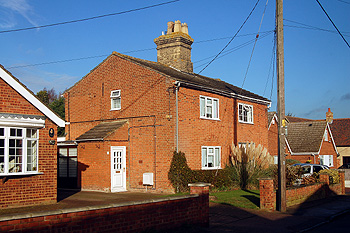Methodists in Pulloxhill
![The site of the chapel in 1846 shown in blue [L12/214]](/CommunityHistories/Pulloxhill/PulloxhillImages/The site of the chapel in 1846 shown in blue [L12-.jpg)
The site of the chapel in 1846 shown in blue [L12/214]
In 1672 Charles II issued a Declaration of Toleration for Protestants dissenting from the Church of England; this had the effect of some dissenting meeting houses registering with the Secretary of State. The Toleration Act of 1689 enshrined the right of Protestants to dissent from the Church of England and, once again, encouraged meeting houses to register voluntarily with local quarter sessions and Anglican Church. Registration provided protection against persecution, laying a duty of protection upon magistrates and so was popular with nonconformists. Most registrations were made with quarter sessions until the middle of the 18th century, presumably due to the mutual antagonism of nonconformists and established Church. However, from that point registration with the Church, via the local archdeaconry began to become the favoured method, because the archdeaconry Registrar would issue a licence at any time rather than during the days each quarter when the quarter sessions met.
Bedfordshire & Luton Archives & Records Service has a reasonable number of registrations of nonconformist meeting houses in both the Quarter Sessions and Archdeaconry of Bedford archives. Registration continued through the 19th century even though persecution faded away - this was because registered buildings were allowed to claim exemption from parish poor rates, were exempt from control by the Charity Commission and were allowed to be licensed to carry out marriages. These things meant that registration became almost compulsory in practice for well established nonconformist meetings. This is fortunate for the local historian because sometimes the only surviving references to a nonconformist meeting occur as registrations. One drawback with the registrations are that they do not usually inform the reader of the particular type of denomination involved, though sometimes it is possible to infer it from other evidence.
Edwin Welch researched the history of registrations in Bedfordshire for Bedfordshire Historical Records Society Volume 75 Bedfordshire Chapels and Meeting Houses [published in 1996] and found four registrations for Pulloxhill, between 1802 and 1837. There is no certain evidence for the denomination of any of these registrations but circumstantial evidence suggests that they might all have been Methodist.
In November 1802 the dwelling house of labourer George Rich was registered by John Crosby Leppington, John Crouch, Thomas Walker, James Cole, James Deamer and John Tompson [ABN1/1; ABN2/109]. Leppington registered a Methodist chapel in Chalgrave in August 1813 [ABN1/1. ABN2/155] and so it seems reasonable to assume that Rich and the others were also Methodists.
The dwelling house of John Tompson (then spelled Thompson) was registered on 27th March 1805 and it seems reasonable to suppose that this, too, would have been a meeting of the Methodist persuasion. On 11th March 1832 the house of John Spendelow or Spedlow was registered by Spendelow himself [ABN1/2, ABN2/67, ABN3/3]. The certificate was addressed to the Bishop of Lincoln, a form much used by Methodists.
The only other registration in Pulloxhill was in September 1837 when a "building recently erected" was registered by Henry Hyde, John Cain and John Neal [ABN1/2, ABN2/319]. As the only denomination for which we have any record in Pulloxhill is Methodist this chapel might well have been a Methodist meeting.
In 1846 a chapel is shown on the site of today's 1-3 Flitton Road in a farm sale particular [L12/214]. This building is not marked as a chapel on the 1st 25 inches to the mile Ordnance Survey map of 1881 and so we can assume that it had ceased to operate by then. Pulloxhill was a small village and did not, perhaps, have enough Methodists to maintain a meeting of its own. There was a Wesleyan Methodist chapel in Greenfield and a Primitive Methodist meeting in Silsoe so it seems likely that Pulloxhill Methodists attended one of these.
 1 and 3 Flitton Road - site of the chapel - November 2011
1 and 3 Flitton Road - site of the chapel - November 2011